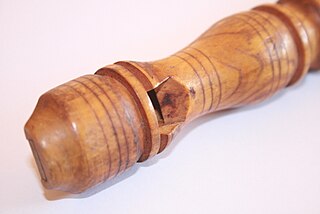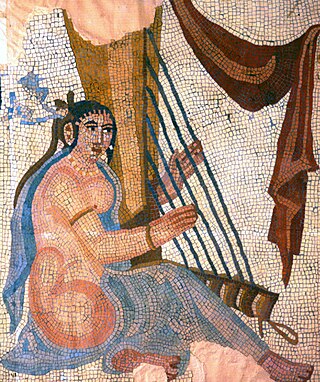Related Research Articles

Acoustics is a branch of physics that deals with the study of mechanical waves in gases, liquids, and solids including topics such as vibration, sound, ultrasound and infrasound. A scientist who works in the field of acoustics is an acoustician while someone working in the field of acoustics technology may be called an acoustical engineer. The application of acoustics is present in almost all aspects of modern society with the most obvious being the audio and noise control industries.
The clarinet is a single-reed musical instrument in the woodwind family, with a nearly cylindrical bore and a flared bell.

The flute is a member of a family of musical instruments in the woodwind group. Like all woodwinds, flutes are aerophones, producing sound with a vibrating column of air. Unlike woodwind instruments with reeds, a flute produces sound when the player's air flows across an opening. In the Hornbostel–Sachs classification system, flutes are edge-blown aerophones. A musician who plays the flute is called a flautist or flutist.

The term fipple specifies a variety of end-blown flute that includes the flageolet, recorder, and tin whistle. The Hornbostel–Sachs system for classifying musical instruments places this group under the heading "Flutes with duct or duct flutes." The label "fipple flute" is frequently applied to members of the subgroup but there is no general agreement about the structural detail of the sound-producing mechanism that constitutes the fipple, itself.

Lund is a city in the southern Swedish province of Scania, across the Öresund strait from Copenhagen, Denmark. The town had 91,940 inhabitants out of a municipal total of 121,510 as of 2018. It is the seat of Lund Municipality, Scania County. The Öresund Region, which includes Lund, is home to more than 4.1 million people.

The Nordic Bronze Age is a period of Scandinavian prehistory from c. 2000/1750–500 BC.

Ancient music refers to the musical cultures and practices that developed in the literate civilizations of the ancient world. Succeeding the music of prehistoric societies and lasting until the Post-classical era. Major centers of Ancient music developed in China, Egypt, Greece, India, Iran/Persia, the Maya civilization, Mesopotamia, and Rome. Though extremely diverse, the music of ancient civilizations is frequently characterized by monophony, improvisation and the dominance of text in musical settings.
Prehistoric music is a term in the history of music for all music produced in preliterate cultures (prehistory), beginning somewhere in very late geological history. Prehistoric music is followed by ancient music in different parts of the world, but still exists in isolated areas. However, it is more common to refer to the "prehistoric" music which still survives as folk, indigenous or traditional music. Prehistoric music is studied alongside other periods within music archaeology.

Music was ubiquitous throughout Mesopotamian history, playing important roles in both religious and secular contexts. Mesopotamia is of particular interest to scholars because evidence from the region—which includes artifacts, artistic depictions, and written records—places it among the earliest well-documented cultures in the history of music. The discovery of a bone wind instrument dating to the 5th millennium BCE provides the earliest evidence of music culture in Mesopotamia; depictions of music and musicians appear in the 4th millennium BCE; and later, in the city of Uruk, the pictograms for ‘harp’ and ‘musician’ are present among the earliest known examples of writing.

The Divje Babe flute, also called tidldibab, is a cave bear femur pierced by spaced holes that was unearthed in 1995 during systematic archaeological excavations led by the Institute of Archaeology of the Research Centre of the Slovenian Academy of Sciences and Arts, at the Divje Babe I near Cerkno in northwestern Slovenia. It has been suggested that it was made by Neanderthals as a form of musical instrument, and became known as the Neanderthal flute. The artifact is on prominent public display in the National Museum of Slovenia in Ljubljana as a Neanderthal flute. As such, it would be the world's oldest known musical instrument.
The Boehm system for the clarinet is a system of clarinet keywork, developed between 1839 and 1843 by Hyacinthe Klosé and Auguste Buffet jeune. The name is somewhat deceptive; the system was inspired by Theobald Boehm's system for the flute, but necessarily differs from it, since the clarinet overblows at the twelfth rather than the flute's octave. Boehm himself was not involved in its development.
Archaeoacoustics is a sub-field of archaeology and acoustics which studies the relationship between people and sound throughout history. It is an interdisciplinary field with methodological contributions from acoustics, archaeology, and computer simulation, and is broadly related to topics within cultural anthropology such as experimental archaeology and ethnomusicology. Since many cultures have sonic components, applying acoustical methods to the study of archaeological sites and artifacts may reveal new information on the civilizations examined.
Ling Lun is the legendary founder of music in ancient China.
Ann Buckley is an Irish musicologist, born in Dublin.

Music archaeology is an interdisciplinary field of study that combines musicology and archaeology. As it includes the study of music from various cultures, it is often considered to be a subfield of ethnomusicology.
Peter Bressan was a noted woodwind instrument maker of whose work several examples exist in museums and private collections.
Anna "Anta" Birgitta Rooth was the first Swedish professor of ethnology at Uppsala University. She is known for her research into folklore, especially the Cinderella story.
References
- ↑ "295 (Vem är hon)". runeberg.org (in Swedish). 1988. Retrieved 2021-04-01.
- ↑ "LUND, CAJSA - A N I M U S I C : Associação Nacional de Instrumentos Musicais / National Association for Musical Instruments - Portugal". www.animusic.eu. Retrieved 2021-04-01.
- ↑ Administrator. "Cajsa S. Lund". www.emaproject.eu. Retrieved 2021-04-01.
- ↑ "European Music Archaeology Project". www.emaproject.eu. Retrieved 2021-04-01.
- 1 2 3 Wild, Sarah (2021-01-12). "The Archaeologists Recreating the Sounds of the Stone Age". Atlas Obscura. Retrieved 2021-04-01.
- ↑ "The People's Instruments – Ruth Ewan" . Retrieved 2021-04-01.
- ↑ "LUND, CAJSA - A N I M U S I C : Associação Nacional de Instrumentos Musicais / National Association for Musical Instruments - Portugal". www.animusic.eu. Retrieved 2021-04-01.
- ↑ Lund, Cajsa S., and G. Jähnichen. "Early Ringing Stones in Scandinavia–Finds and Traditions, Questions and Problems." [ dead link ]Studia instrumentorum musicae popularis I (2009).
- ↑ Lund, Cajsa S. "Prehistoric Soundscapes in Scandinavia." Sounds of History (2008): 12.
- ↑ Lund, Cajsa S. (1985). "Bone Flutes in Västergötland, Sweden. Finds and Traditions. A Music-Archaeological Study". Acta Musicologica. 57 (1): 9–25. doi:10.2307/932685. ISSN 0001-6241. JSTOR 932685.
- ↑ Emsheimer, Ernst; Lund, Cajsa (1983). "A Swedish Bone Clarinet". The Galpin Society Journal. 36: 125–127. doi:10.2307/841683. ISSN 0072-0127. JSTOR 841683.
- ↑ Lund, Cajsa (1981). "A Medieval Tongue-(Lip-)and-Duct Flute". The Galpin Society Journal. 34: 106–109. doi:10.2307/841474. ISSN 0072-0127. JSTOR 841474.
- ↑ Lund, Cajsa (1981). "The Archaeomusicology of Scandinavia". World Archaeology. 12 (3): 246–265. doi:10.1080/00438243.1981.9979799. ISSN 0043-8243. JSTOR 124236.
- ↑ Lund, Cajsa (1980). "Methoden und Probleme der nordischen Musikarchäologie. Ernst Emsheimer zugeeignet". Acta Musicologica. 52 (1): 1–13. doi:10.2307/932431. ISSN 0001-6241. JSTOR 932431.
- ↑ Lund, Cajsa; EXARC Experimental Archaeology Collection Manager (1984). Fornnordiska klanger.The Sounds of Prehistoric Scandinavia,. Booklet and CD. Swedish Music Anthology. Vol. MSCD101. EXARC Experimental Archaeology Collection Manager.
- ↑ admin. "Högsta utmärkelsen till fem musikpersonligheter | iMusiken" (in Swedish). Retrieved 2021-04-01.
- ↑ "Caves, Tombs and Megaliths: Sound Archaeology and the Development of Ritual Acoustics". University of Huddersfield Research Portal. Retrieved 2021-04-01.
- ↑ Lund, Cajsa S.; Rainio, Riitta; Holtorf, Cornelius; Tamboer, Annemies; Morley, Iain; Homo-Lechner, Catherine; Castro, Emiliano Li; Till, Rupert; Gill, Frances (2020). The Archaeology of Sound, Acoustics and Music: Publications of the ICTM Study Group on Music Archaeology, Vol. 3: Studies in Honour of Cajsa S. Lund. Ekho Verlag. ISBN 978-3-944415-39-0.